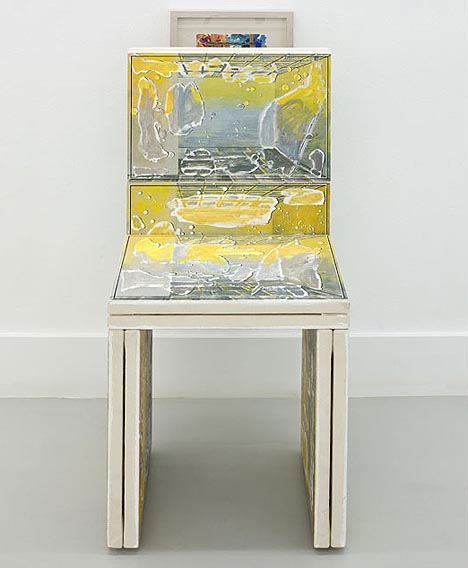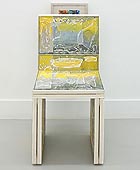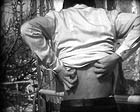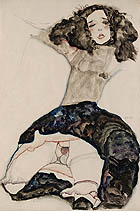
translated and summarized by: Liz Wollner-Grandville,
English summaries November 1 - 13
Galerie Grita Insam
Art & Language
28.09.11 - 19.11.11
In the labyrinth of representation
Encountering works by Art & Language is always a remarkable déjà-vu. The onlooker dives into a meta-language that analyzes and sometimes ironically upends the forms of exhibiting, presenting, and showing art, whereby Art & Language nearly exclusively refers to the European-American tradition of Modernism. At the same time, the British-American art group repeatedly uses spatial constructions similar to designer objects or furniture. Frequently they are covered with colored stripes positioned in a right angle towards each other and offering the basis for theoretical texts. Even those who started to subvert certain ingrained patterns of awareness have long reached the status of a trademark.
You may remember: In the 1970’s, the artist group, which first appeared in changing formations and later mainly with its main members Michael Baldwin and Mel Raamsden, dealt with questions pertaining to the production of art. Primarily because they strived to change the focus from classic non-verbal orientated forms of expression such as painting, sculpture or photography to theory and language; and, with their analytical investigations, they significantly contributed to the strengthening of conceptual art.
Besides temporary affiliations to Pop avant-garde groups such as „The Red Crayola“ oder „Pere Ubu“, Art & Language operated in the intersection of art, architecture and design. Just like works of art can serve as decorations in the real world, Art & Language question the ideological conditions that dominate in exhibition rooms of Modernism and literally make everything part of a dialogue. But in the meantime they are not only brands with brand recognition. Sometimes Art & Language are also amusing. At least in some of the works shown at the Galerie Grita Insam.
Today, their work leads to intimate situations and canvas is given a new purpose - it covers objects that appear like furniture. The canvases themselves – which remind of the geometry of the colored fields in Modernism – are references to former Art & Language works, while a hardly visible photograph of their studio – the “ideological room”, hangs in the background. Art & Language explain that behind the – lets call it installation – Offical Squares Again (2009 – 2010) – there is no other work. Instead, Malevich is paraphrased; in a showcase there are badges reminding of a dream that Malevich could have had of Stalin.
Every cruelty that art history has to offer is ridiculed with British humor. Art & Language are part of the historic avant-garde that - influenced by the so-called Linguistic Turn, but also by Wittgenstein and Post-Structuralism - questions conditions of our perception within the operating system of art. The Gallery Grita Insam who, over the past 40 years, brought important positions of genre-spanning contemporary art to Vienna, were devoted to Art & Language by. Now, the gallery that played such an active part in Vienna’s art history will close down for reasons of health.
By Roland Schöny
Galerie Grita Insam
1010 Vienna, An der Hülben 3
Tel: + 43 1 512 53 30
Fax: +43 1 512 5330 15
email: office@galeriegritainsam.at
www.galeriegritainsam.at
Opening hours: Tue – Fri 12 – 18 hours, Sat 11 – 16 hours
Otten Kunstraum
Karl-Heinz Ströhle - Ornament and Aformation
28.09.11 - 31.05.12
A (small) revelation
Today, the old oil tower on the Otten-property in Hohenems in Vorarlberg’s Rheintal region serves as a “Black Cube”. The “Video in the oil tank – Gerda 2011” that is currently being presented in the tower is nothing less than a (small) revelation.
In the interior of this circular space, the video is projected onto the wall like a Gothic rose window; no Christ in its center but a dancer dressed in black, arching its way through the steel bands like a caterpillar in a cocoon. The bendable spring steel, which always returns to its original form from its deformation or “aformation” as the artist calls it, could doubtlessly be regarded as the nub of the matter of Karl-Heinz Ströhles work. These three dimensional motions are transformed into two-dimensional ones in his paintings, which comprise the major part of his oeuvre. There is a certain closeness to Jackson Pollock’s “All over” when it appears as if complicated but actually simple mathematical calculations determine the balance of his works.
The chubby forms also remind of Picasso or Henry Moore. University professor Bazon Brock reaches for the stars with Goethe and Punk, when he tries to position “Ströhle’s Aformatons”, in an extensive intellectual historic context described in the accompanying English/German catalogue. Ströhle was a former student of his at the University of Applied Arts in 1979 – 80.
The Hohenems-based textile company Otten is one of the last dinosaurs of the nearly extinct Vorarlberg textile industry. Wilhelm Otten crowned his collection with the exhibition in his Otten Kunstraum. Today, the large property serves as an accommodation for chic upper-class parties, selling furniture and clothing for the Catholic charity organization Caritas and as a sorting hall for the regional post office. There are also numerous outdoor-sculptures, among others created by Tone Fink and the recently acquired 3 X 3.9 m spring steel sculpture by Karl-Heinz Ströhle. The concept of making industrial buildings located in the quiet southern outskirts of Hohenems more interesting and worthwhile visiting, gains full momentum with works by top-class artists such as Karl-Heinz Ströhle.
By Wolfgang Ölz
Otten Kunstraum
6845 Hohenems, Schwefelbadstrasse 2
Tel: +43 5576 90 400
Fax: +43 5576 70 4200
email: mail@ottenkunstraum.at
www.ottenkunstraum.at
Opening hours: Do 16:00 - 20:00 hours
Badischer Kunstverein
Hamlet Hovsepian - Head, Itch, Washing Hair, Yawning, Biting Nails
30.09.11 - 27.11.11
Cinema Yerevan
He once said that great people such as Bunuel, Pasolini, Fellini, Godard, Chabrol or Truffaut influenced him. He had read about all of their films, but had never seen one of them. In the mid 70’s, the artist, who is now considered to be one of the pioneers of concept art in the Soviet Union, created his works in the small village of Ashnak near Yerevan.
Hamlet Hovespian’s idea was to rid movies of drama, he said in unpublished conversation with the curators Anja Casser and Daniel Pies, who are now showing four films by the Armenian conceptualist in the first solo presentation at the Badische Kunstverein in Karlsruhe. Vienna’s Filmmuseum contributed to the exhibition by saving and copying the old films in the original 16mm format, allowing the presentation of the scratched and otherwise damaged material to be accompanied by the buzzing sound of a player.
A man continuously yawning, a young women biting her fingernails, someone permanently scratching his back – all of these practically unconsciously performed acts of boredom, all staged in a loop - without a beginning, end or climax. Even the young man who incessantly circles a rock seems to lack all intention to interrupt his action to at least attempt to move the rock. These minimalistic activities would be the “result of a small revolt against the deadly passivity of society”, said Georg Schöllhammer 2004. “Hovsepian’s reduction, his silence provides a general deflection to the significance of emptiness, abstract space and manifold expanded time.”
Can one criticize in isolation? In principle yes, but it could take decades before it is noticed.
By Daniela Gregori
Badischer Kunstverein
76133 Karlsruhe, Waldstraße 3
Tel: +49(0)721 28226
Fax: +49(0)721 29773
www.badischer-kunstverein.de
Opening hours: Tue - Fri 11-19 hours, Sat, Sun 11-17 hours
Leopold Museum
Melancholia and Provocation – The Egon Schiele Project
23.09.11 – 30.01.12
Schiele and the Plasma-Plum
The frustration that may be felt regarding the existence of life is ennobled by the word ‘melancholia’. He who is furious because one has to suffer in life, provokes those who don’t suffer so they may in turn suffer – and the anger is no longer his alone.
One cannot claim that Egon Schiele did not have a furiously melancholic youth. Many artists start with their work-mania at a very early age but live a long life and make changes at a later stage. If Schiele would have counteracted his mushy-dull landscapes during the course of his successful artist’s life with sleek and sunny southern light images, remains speculation. There can be no question that he is both a self- as well as a women portraitist who doesn’t paint anything that is unnecessary and he doesn’t add anything superfluous, thereby pre-empting a painting as such.
With the extensive exhibition “Melancholia and Provocation” the Leopold Museum offers him an arena in which – in addition to the art historic reference to Schiele’s contemporaries such as Feuerbach, Kokoschka and Max Oppenheimer - works by Austrian artists born later are shown in six separate rooms and interact with Schiele’s paintings. The radicalism of Schiele’s depictions are echoed in Günther Brus' and Rudolf Schwarzkogler's action photographs. In his videos, Philipp Gehmacher concentrates on body-language melancholia. The everywhere-grey, even on shutters and vent slots next to the larger work in Gehmachers’s room could offer a mild relaxation to the lush maroon and dark blue Schiele-in-his-time-rooms, if it weren’t for the constant whispering emerging form the headphones in the adjacent room by Claudia Bosse, which also interferes with Franz Graf's rigid black-and-white construction. He cites, pleasantly dressed, the whore-saint-topic in occidental female worship next to two large diptychs of black-and-white Madonna replicas behind glass and with protective Styrofoam, before one can marvel at Elke Krystufek’s male torsos created in basic colours. In the face of one of her maybe-Jesus protagonists she lets colours float in a way that puts Kokoschka’s brawny self-portrait into perspective and proves that an artist should not always apply paint over the entire picture. Should questions on melancholia and provocation remain unanswered, one could feel slightly distressed that one did not see any works by Maria Lassnig. But if one imagines what the impression of Vienna will be on guests from around the globe if they see that Egon Schiele painted his model’s private parts like a maroon plum – should one not assume that they will dream of Schiele and stewed plum forever?
By Gesche Heumann
Leopold Museum
1070 Vienna, Museumsquartier
Tel: 0043 1 525 70 – 0
Fax: 00423 1 525 70 1500
Email: leopoldmuseum@leopoldmuseumorg
www.leopoldmuseum.org
Opening hours: Wed – Mon 11 – 19 hours, Fri 11 – 21 hours
Mehr Texte von translated and summarized by: Liz Wollner-Grandville


 Teilen
Teilen




